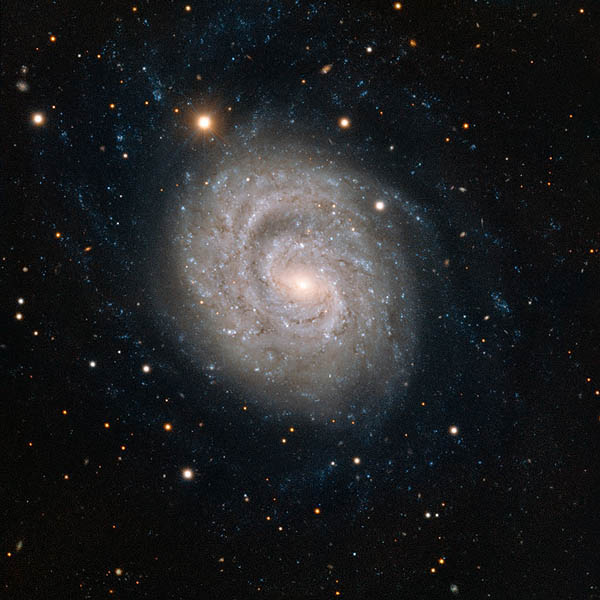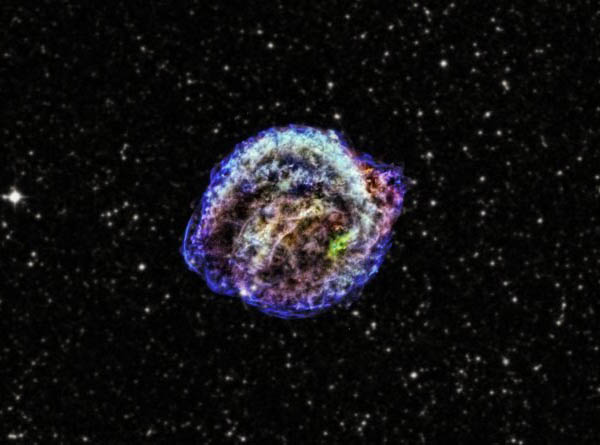Here are some beautiful space photos and videos that have been posted on the Internet recently. Enjoy!

The giant star Zeta Ophiuchi is having a “shocking” effect on the surrounding dust clouds in this infrared image from NASA’s Spitzer Space Telescope. Stellar winds flowing out from this fast-moving star are making ripples in the dust as it approaches, creating a bow shock seen as glowing gossamer threads, which, for this star, are only seen in infrared light.
Zeta Ophiuchi is a young, large and hot star located around 370 light-years away. It dwarfs our own sun in many ways — it is about six times hotter, eight times wider, 20 times more massive, and about 80,000 times as bright. Even at its great distance, it would be one of the brightest stars in the sky were it not largely obscured by foreground dust clouds.
This massive star is travelling at a snappy pace of about 54,000 mph (24 kilometers per second), fast enough to break the sound barrier in the surrounding interstellar material. Because of this motion, it creates a spectacular bow shock ahead of its direction of travel (to the left). The structure is analogous to the ripples that precede the bow of a ship as it moves through the water, or the sonic boom of an airplane hitting supersonic speeds.
The fine filaments of dust surrounding the star glow primarily at shorter infrared wavelengths, rendered here in green. The area of the shock pops out dramatically at longer infrared wavelengths, creating the red highlights.
A bright bow shock like this would normally be seen in visible light as well, but because it is hidden behind a curtain of dust, only the longer infrared wavelengths of light seen by Spitzer can reach us.
Bow shocks are commonly seen when two different regions of gas and dust slam into one another. Zeta Ophiuchi, like other massive stars, generates a strong wind of hot gas particles flowing out from its surface. This expanding wind collides with the tenuous clouds of interstellar gas and dust about half a light-year away from the star, which is almost 800 times the distance from the sun to Pluto. The speed of the winds added to the star’s supersonic motion result in the spectacular collision seen here.
Our own sun has significantly weaker solar winds and is passing much more slowly through our galactic neighborhood so it may not have a bow shock at all. NASA’s twin Voyager spacecraft are headed away from the solar system and are currently about three times farther out than Pluto. They will likely pass beyond the influence of the sun into interstellar space in the next few years, though this is a much gentler transition than that seen around Zeta Ophiuchi.
For more information, see www.jpl.nasa.gov/spaceimages/details.php?id=PIA16604

About 35 million light-years from Earth, in the constellation of Eridanus (The River), lies the spiral galaxy NGC 1637. Back in 1999 the serene appearance of this galaxy was shattered by the appearance of a very bright supernova. Astronomers studying the aftermath of this explosion with ESO’s Very Large Telescope at the Paranal Observatory in Chile have provided us with a stunning view of this relatively nearby galaxy.
Supernovae are amongst the most violent events in nature. They mark the dazzling deaths of stars and can outshine the combined light of the billions of stars in their host galaxies.
In 1999 the Lick Observatory in California reported the discovery of a new supernova in the spiral galaxy NGC 1637. It was spotted using a telescope that had been specially built to search for these rare, but important cosmic objects. Follow-up observations were requested so that the discovery could be confirmed and studied further. This supernova was widely observed and was given the name SN 1999em. After its spectacular explosion in 1999, the supernova’s brightness has been tracked carefully by scientists, showing its relatively gentle fading through the years.
The star that became SN 1999em was very massive — more than eight times the mass of the Sun — before its death. At the end of its life its core collapsed, which then created a cataclysmic explosion.
When they were making follow up observations of SN 1999em astronomers took many pictures of this object with the VLT, which were combined to provide us with this very clear image of its host galaxy, NGC 1637. The spiral structure shows up in this image as a very distinct pattern of bluish trails of young stars, glowing gas clouds and obscuring dust lanes.
Although at first glance NGC 1637 appears to be a fairly symmetrical object it has some interesting features. It is what astronomers classify as a lopsided spiral galaxy: the relatively loosely wound spiral arm at the top left of the nucleus stretches around it much further than the more compact and shorter arm at the bottom right, which appears dramatically slashed midway through its course.
Elsewhere in the image the view is scattered with much closer stars and more distant galaxies that happen to lie in the same direction.
For more information, see http://www.eso.org/public/news/eso1315/

This is the remnant of Kepler’s supernova, the famous explosion that was discovered by Johannes Kepler in 1604. The red, green and blue colors show low, intermediate and high energy X-rays observed with NASA’s Chandra X-ray Observatory, and the star field is from the Digitized Sky Survey.
A new study has used Chandra to identify what triggered this explosion. It had already been shown that the type of explosion was a so-called Type Ia supernova, the thermonuclear explosion of a white dwarf star. These supernovas are important cosmic distance markers for tracking the accelerated expansion of the Universe.
However, there is an ongoing controversy about Type Ia supernovas. Are they caused by a white dwarf pulling so much material from a companion star that it becomes unstable and explodes? Or do they result from the merger of two white dwarfs?
The new Chandra analysis shows that the Kepler supernova was triggered by an interaction between a white dwarf and a red giant star. The crucial evidence from Chandra was a disk-shaped structure near the center of the remnant. The researchers interpret this X-ray emission to be caused by the collision between supernova debris and disk-shaped material that the giant star expelled before the explosion. Another possibility was that the structure is just debris from the explosion.
The disk structure seen by Chandra in X-rays is very similar in both shape and location to one observed in the infrared by the Spitzer Space Telescope. This composite image shows Spitzer data in pink and Chandra data from iron emission in blue. The disk structure is identified with a label.
This composite figure also shows a remarkably large and puzzling concentration of iron on one side of the center of the remnant but not the other. The authors speculate that the cause of this asymmetry might be the “shadow” in iron that was cast by the companion star, which blocked the ejection of material. Previously, theoretical work has suggested this shadowing is possible for Type Ia supernova remnants.
The authors also produced a video showing a simulation of the supernova explosion as it interacts with material expelled by the giant star companion. It was assumed that the bulk of this material was expelled in a disk-like structure, with a gas density that is ten times higher at the equator, running from left to right, than at the poles. This simulation was performed in two dimensions and then projected into three dimensions to give an image that can be compared with observations. The good agreement with observations supports their interpretation of the data.
These results were published online and in the February 10th, 2013 issue of The Astrophysical Journal.
Credits: X-ray: NASA/CXC/NCSU/M.Burkey et al; Infrared: NASA/JPL-Caltech; www.nasa.gov/mission_pages/chandra/multimedia/kepler2013.html
Here is some new NASA video showing the “Surface of the Sun As You’ve Never Seen It.”
This is a beautiful video taken on the Gaislachkogel Mountain, Oetztal, Austria of Comet PanSTARRS!